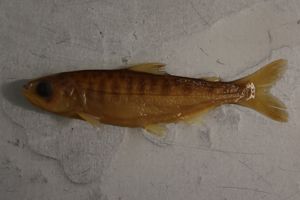Chinook salmon
Oncorhynchus tshawytscha
Family: Salmonidae (Salmon and Trout)
Etymology: Onco = hooked or bent; rhynchus = nose or snout; tshawytscha = Russian name for this fish
One of seven Pacific salmon, the Chinook salmon is of tremendous ecological, economic and cultural value in the Sacramento region. Like most of the other Pacific salmon, Chinook are anadromous, meaning that they spawn in freshwater, migrate to the ocean to grow, then return to freshwater to spawn (Gross et al. 1988). Remarkably, they often return within a few feet of where they were hatched years before. In the Lower American River, there are both natural chinook salmon, as well as Chinook produced at the Nimbus Fish Hatchery. Visitors can see the fish swimming/jumping up the fish ladder at Nimbus in the fall (e.g., October). The adults are then "spawned" manually. Alternatively, if you walk along the river trail, just downstream of the hatchery, there are several good locations for seeing Chinook spawn in the river itself.
Interestingly, not all adults return to their natal stream; some adults "stray" to nearby rivers and streams. Understanding the causes of "straying" is an important and interesting topic (Lasko et al., 2014).
Wild versus hatchery fish
This is a topic of considerable controversey: are hatchery fish an aide to or a detriment to wild populations of fishes like the Chinook salmon? On the one hand, hatcheries produce vast numbers of Chinook, far more than the fish spawning naturally in the river. The reason for this is that there is much less natural spawning habitat in the river since the construction of the Folsom and Nimbus dams in 1955(?). The dams effectively cut off the upper reaches of the American River from spawning salmonids. On the other hand, there are a number of problems with hatchery-produced fish. First, they do not behave the same as wild fish, e.g., hatchery-raised fish are used to being fed from a machine that scatters food over the surface of their tank. This is in contrast to juvenile wild salmon which learn to forage for food along the bottom of the river and tend to shun the surface because a young fish near the surface is susceptible to avian (bird) predators. In addition, at the other end of its life, returning hatchery salmon do not have to compete for mates. The individuals are selected by hatchery staff, slit open and the eggs and milt (sperm) mixed by humans. Naturally spawning Chinook have elaborate nesting and courtship behavior to allow females to choose the best mate. (to be continued, e.g., Ian Fleming's research).
Chinook figure hugely in water regulation in California (to be continued).
Research on Chinook salmon done by Sac State researchers
Lasko, G.R., R.G. Titus, J.R. Ferreira, and R.M. Coleman (2014) Straying of late-fall run Chinook salmon from the Coleman National Fish Hatchery into the lower American River, California. California Fish and Game 100(4):665-682. pdf
Gross, M.R., R.M. Coleman, R.D. McDowall (1988) Aquatic productivity and the evolution of diadromous fish migration. Science 239:1291-1293. pdf
